December is Disney month at EFSP! Last year, we had posts with vintage postcards of several, wonderful classic features by the Walt Disney studio. This year we will update some of these posts and we'll introduce new ones about other unforgettable Disney classics. Marlene Pilaete will make a 'La Collectionneuse' post for us about classic Disney heroines, and 'Disney December at EFSP' starts with a double post on a special French postcard series. In the mid-1950s, chocolate factory Tobler produced a delightful series of 'cartes postales' with Disney heroes. The series presented the main figures of the classic features but also secondary characters. And it covered the silly symphonies of the 1930s, the Latin American films of the war years like Saludos Amigos (1943) and also such forgotten 'package films' as Song of the South (1946). Tomorrow follows a second post on the period 1947-1955, and today we'll start with the early years.

French postcard by Imp. Georges Lang, Paris, offered by Chocolats Tobler. Image: Walt Disney.
Pete or Peg-Leg Pete is a villainous cat created by Walt Disney and Ub Iwerks. Pete first appeared in Alice Solves the Puzzle (1925). He is the arch-nemesis of Mickey Mouse, normally characterised as a cigar-smoking thug with a ruthless and tyrannical personality. Some of Pete’s most notable traits include his Herculean strength and thunderous cackle. Pete’s most frequent scheme involves kidnapping Minnie Mouse for lecherous purposes.

French postcard by Imp. Georges Lang, Paris, offered by Chocolats Tobler. Image: Walt Disney.
Fifer Pig and Fiddler Pig are two of the three little pigs of the classic Silly Symphonies short Three Little Pigs (Burt Gillett, 1933) and its three follow-up shorts, The Big Bad Wolf (Burt Gillett, 1934), Three Little Wolves (Burt Gillett, David Hand, 1936), and The Practical Pig (Dick Rickard, 1939). The three pigs are constantly targeted by the Big Bad Wolf, who wants to eat them for dinner.

French postcard by Imp. Georges Lang, Paris, offered by Chocolats Tobler. Image: Walt Disney.
Practical Pig is one of the three little pigs of the classic Silly Symphonies short Three Little Pigs (Burt Gillett, 1933) and its three follow-up shorts, The Big Bad Wolf (Burt Gillett, 1934), Three Little Wolves (Burt Gillett, David Hand, 1936), and The Practical Pig (Dick Rickard, 1939). The three pigs are constantly targeted by the Big Bad Wolf, who wants to eat them for dinner.

French postcard by Imp. Georges Lang, Paris, offered by Chocolats Tobler. Image: Walt Disney.
The Big Bad Wolf is the main antagonist of the Silly Symphonies short Three Little Pigs (Burt Gillett, 1933) and its sequels. As his name suggests, he is a ruthless, conniving wolf who constantly plots to capture and eat the Three Little Pigs.
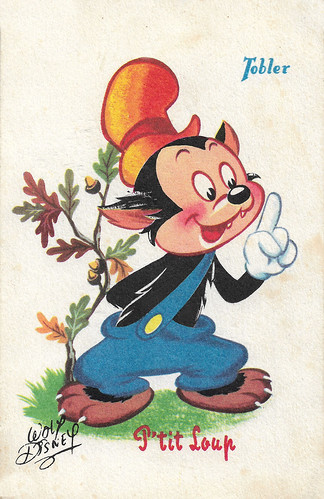
French postcard by Imp. Georges Lang, Paris, offered by Chocolats Tobler. Image: Walt Disney.
Disney's Li'l Bad Wolf or Li'l Wolf is the son of Zeke the Big Bad Wolf. Li'l Wolf debuted in his own self-titled series, beginning in the comic book 'Walt Disney's Comics and Stories #52' (1945). In spite of his name, Li'l Bad Wolf is the exact opposite of his father. He wants to be a good little wolf. Zeke wants his son to be just as bad as he is, but the kindhearted Li'l Wolf, despite wanting to please his father, can't bring himself to do others harm. Even worse for Zeke, Li'l Wolf's best friends are the Three Little Pigs, and, where his father is continuously plotting ways to capture the pigs, Li'l Wolf constantly has to invent ways to help save his friends from his father's appetite.

French postcard by Imp. Georges Lang, Paris, offered by Chocolats Tobler. Image: Walt Disney.
Grandpa Bunny was introduced in the Silly Symphony Funny Little Bunnies (Wilfred Jackson, 1934). In the seven-minutes short, bunny rabbits are preparing for Easter, by making chocolate eggs and rabbits are decorating eggs, and weaving and filling baskets. In 1951, Grandpa returned in the little Golden Book 'Grandpa Bunny'. It tells the touching story of (now) Great-Grandpa Bunny Bunny, who teaches each new generation of bunnies how to prepare for the coming spring. The story was told by Jane Werner with illustrations by the Walt Disney Studio adapted by Dick Kelsey and Bill Justice from Funny Little Bunnies (1934). Cole Sear at IMDb about the short: "Funny Little Bunnies is whimsical Disney animation at its best and its unapologetically funny. (...) The story is simple and humorous without being too dumb and the animation- which I suspect was done on 3-strip technicolor is beautiful."
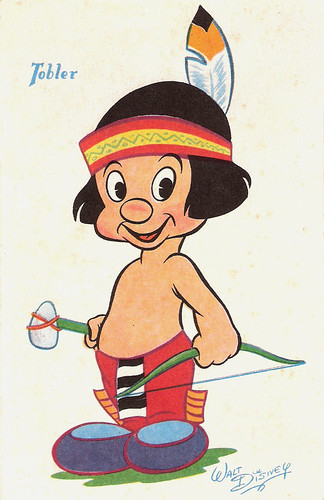
French postcard by Imp. Georges Lang, Paris, offered by Chocolats Tobler. Image: Walt Disney.
"Little Hiawatha" (or simply Hiawatha is a little Indian hunter who hunts for the game. He is the hero of the Silly Symphony Little Hiawatha (David Hand, 1937).
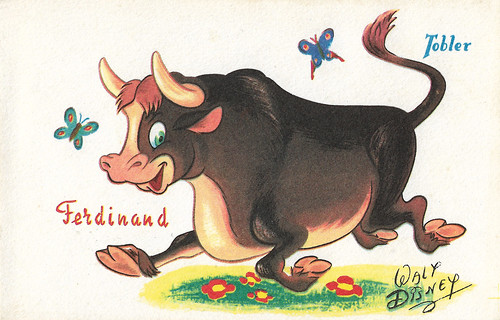
French postcard by Imp. Georges Lang, Paris, offered by Chocolats Tobler. Image: Walt Disney.
Ferdinand is the quiet, gentle bull who, instead of being fierce in the bullring, only wants to smell the flowers in Disney's animated short Ferdinand the Bull (Dick Rickard, 1938). When he is stung by a bee, the townspeople believe he is ferocious and they take him to the bullfight. Ferdinand was voiced by animator Milt Kahl.
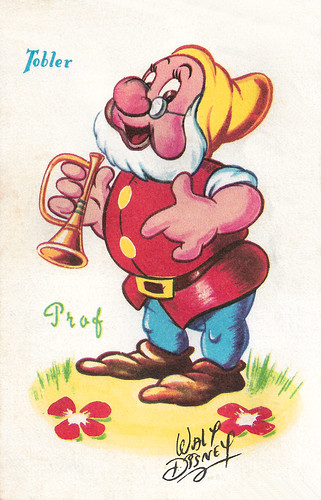
French postcard by Imp. Georges Lang, Paris, offered by Chocolats Tobler. Image: Walt Disney. Publicity still for Snow White and the Seven Dwarfs (William Cottrell, David Hand, Wilfred Jackson, Larry Morey, Perce Pearce, Ben Sharpsteen, 1937). Caption: Prof (Doc).
Snow White and the Seven Dwarfs (William Cottrell, David Hand, Wilfred Jackson, Larry Morey, Perce Pearce, Ben Sharpsteen, 1937) was produced by Walt Disney Productions and originally released by RKO Radio Pictures. It was the first full-length cel-animated feature film and the earliest Disney animated feature film. Walt Disney turned the German fairy tale by the Grimm brothers into a charming family film that is still holding up very well more than 80 years later.

French postcard by Imp. Georges Lang, Paris, offered by Chocolats Tobler. Image: Walt Disney. Publicity still for Snow White and the Seven Dwarfs (William Cottrell, David Hand, Wilfred Jackson, Larry Morey, Perce Pearce, Ben Sharpsteen, 1937). Caption: Simplet (Dopey).
Snow White and the Seven Dwarfs (William Cottrell, David Hand, Wilfred Jackson, Larry Morey, Perce Pearce, Ben Sharpsteen, 1937) was immediately embraced both by critics and audiences and received a special Academy Award in 1938. The songs of the film, like the dwarfs song as they bathe "Whistle While You Work", their "Heigh Ho" and Snow White's anthem "Some Day My Prince Will Come", became evergreens. They were composed by Frank Churchill and Larry Morey.

French postcard by Imp. Georges Lang, Paris, offered by Chocolats Tobler. Image: Walt Disney.
The second full length animated Disney classic, Pinocchio (Hamilton Luske, Ben Sharpsteen, a.o., 1940), is based on the 19th century Italian novel of the same name by Carlo Collodi. The kind woodcarver Geppetto creates a wooden marionette, which he calls Pinocchio. His wish for Pinocchio to be a real boy is unexpectedly granted by a fairy. The fairy assigns Jiminy Cricket to act as Pinocchio's 'conscience' and keep him out of trouble. Pinocchio is weak-willed and Jiminy is not too successful in his endeavour. Pinocchio doesn't always listen to reason and most of the film he is deep in trouble. The story has never a dull moment. In fact Pinocchio is about childhood and temptation. Tasting jam, stealing, not going to school, lying, childhood is full of temptations. Everything is new then everything looks pretty. When the standard for kids is to obey to authoritarian figures who know the best for them, the most precious lesson in Pinocchio is not to obey for the sake of obedience but to follow your conscience. Differentiate between right or wrong. That's what being a real boy is about, being unselfish, trusting, and brave, not being obedient.
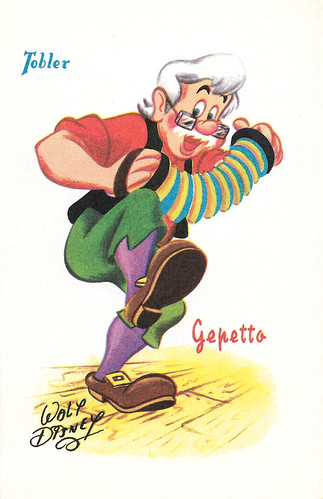
French postcard by Imp. Georges Lang, Paris, offered by Chocolats Tobler. Image: Walt Disney.
The kindly, old woodcarver Geppetto is the creator of the wooden puppet Pinocchio in Disney's animation classic, Pinocchio (Hamilton Luske, Ben Sharpsteen, 1940). Per Geppetto's wish to have a son, Pinocchio is brought to life by the Blue Fairy.

French postcard by Imp. Georges Lang, Paris, offered by Chocolats Tobler. Image: Walt Disney.
Cleo is Geppetto's pet goldfish in Disney's animated classic Pinocchio (Hamilton Luske, Ben Sharpsteen, 1940).

French postcard by Imp. Georges Lang, Paris, offered by Chocolats Tobler. Image: Walt Disney.
Figaro is Geppetto's pet Tuxedo Cat in Disney's animated classic Pinocchio (Hamilton Luske, Ben Sharpsteen, 1940). He later appeared as Minnie Mouse's cat in several cartoon shorts.

French postcard by Imp. Georges Lang, Paris, offered by Chocolats Tobler. Image: Walt Disney.
The Blue Fairy is the magical being in Disney's Pinocchio. Fulfilling Geppetto's wish, she transforms Pinocchio (Hamilton Luske, Ben Sharpsteen, 1940) into a living being and later into a real boy. She also aids Pinocchio and Jiminy Cricket throughout their adventures, both directly and from afar. As one of only two female characters in the film (the other being Cleo), she is the most powerful character in the cast. The Blue Fairy initially grants Pinocchio life and who ultimately decides whether or not he should become a real boy.

French postcard by Imp. Georges Lang, Paris, offered by Chocolats Tobler. Image: Walt Disney.
Jiminy Cricket is the wisecracking cricket in Disney's animated classic Pinocchio (Hamilton Luske, Ben Sharpsteen, 1940). He later also appeared in Fun and Fancy Free (Jack Kinney, Bill Roberts, Hamilton Luske, William Morgan, 1947). Jiminy is depicted donning a top hat and tailcoat, with an umbrella always on his person. He is appointed Pinocchio's official conscience by the Blue Fairy, in hopes that Jiminy can guide Pinocchio on his journey to become a real boy.

French postcard by Imp. Georges Lang, Paris, offered by Chocolats Tobler. Image: Walt Disney.
J. Worthington Foulfellow also is known as Honest John is the con-artist fox who regularly swindles the residents of a small village with the aid of his bumbling sidekick, Gideon, in Disney's Pinocchio (Hamilton Luske, Ben Sharpsteen, 1940). Though a seasoned crook, Honest John is soft-spoken and charismatic. His schemes are typically smaller scale, but he is no stranger to darker tasks.

French postcard by Imp. Georges Lang, Paris, offered by Chocolats Tobler. Image: Walt Disney.
The cat Gideon is the sidekick of Honest John, a shifty con artist in Disney's Pinocchio (Hamilton Luske, Ben Sharpsteen, 1940). Gideon is undoubtedly loyal, but his drunken fumbling does more to annoy Honest John, than assist.
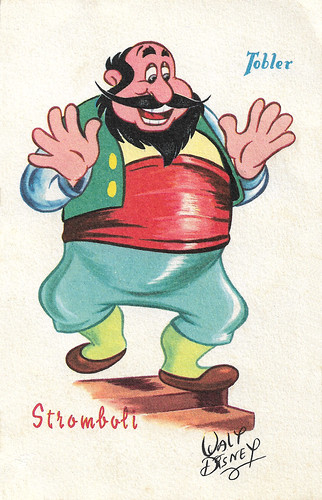
French postcard by Imp. Georges Lang, Paris, offered by Chocolats Tobler. Image: Walt Disney.
Stromboli is the evil puppeteer and showman in Disney's Pinocchio (Hamilton Luske, Ben Sharpsteen, 1940). His ambition is to make good money even if it's at the expense of others.

French postcard by Imp. Georges Lang, Paris, offered by Chocolats Tobler. Image: Walt Disney.
The Coachman is a sinister, shadowy figure in Disney's animated classic Pinocchio (Hamilton Luske, Ben Sharpsteen, 1940). He is notorious for luring "stupid little boys" to Pleasure Island, where they are transformed into donkeys and sold on the black market.

French postcard by Imp. Georges Lang, Paris, offered by Chocolats Tobler. Image: Walt Disney.
Lampwick is a tough, older boy from the streets, who becomes friends with Pinocchio on their way to Pleasure Island in Disney's animated feature film Pinocchio (1940). Lampwick is based upon the character Lucignolo (Candlewick) from the Italian story 'Pinocchio' by Carlo Collodi.

French postcard by Imp. Georges Lang, Paris, offered by Chocolats Tobler. Image: Walt Disney.
Casey Junior is a young steam locomotive from Disney's classic Dumbo (Ben Sharpsteen, 1941). His name is a direct reference to Casey Jones, the famous railroad engineer who had lost his life in a train collision in 1900.
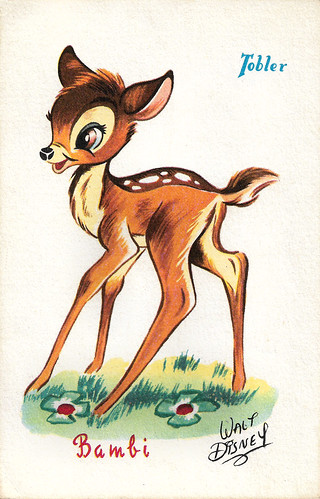
French postcard by Tobler. Image: Walt Disney.
Bambi (David Hand, 1942) was the fifth animated feature produced by Walt Disney. It is based on the book Bambi, a Life in the Woods by Austrian author Felix Salten. The film was released by RKO Radio Pictures in 1942, and received three Academy Award nominations: Best Sound (Sam Slyfield), Best Song (for Love Is a Song sung by Donald Novis), and Original Music Score.
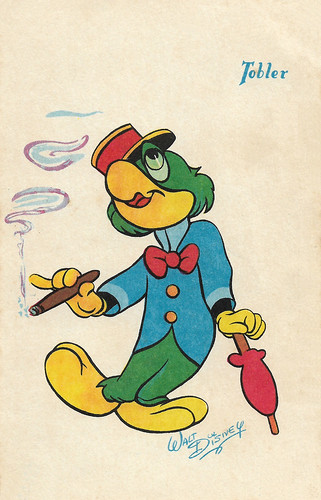
French postcard by Imp. Georges Lang, Paris, offered by Chocolats Tobler. Image: Walt Disney.
José Carioca is an anthropomorphic Brazilian parrot that first appeared in Disney's animated feature film Saludos Amigos (1943). A slick and debonair malandro from Rio de Janeiro, José met and befriended Donald Duck during the latter’s trip to South America. In later years, José joined Donald and the rambunctious rooster Panchito Pistoles as a member of the Three Caballeros (1944).

French postcard by Imp. Georges Lang, Paris, offered by Chocolats Tobler. Image: Walt Disney.
Mexican rooster Panchito Pistoles first appeared in Disney's The Three Caballeros (Norman Ferguson, a.o., 1945). Panchito lives in Mexico and rides on a horse called Señor Martinez.He is a bombastic, trigger-happy caballero that becomes instant friends with Donald Duck and José Carioca.

French postcard by Tobler. Image: Walt Disney.
Br'er Rabbit is the protagonist of the animated sequences of the Disney feature film Song of the South (Harve Foster, Wilfred Jackson, 1946).

French postcard by Imp. Georges Lang, Paris, offered by Chocolats Tobler. Image: Walt Disney.
Brother Fox or Br'er Fox is the main antagonist in the animated sequences of Song of the South (Harve Foster, Wilfred Jackson, 1946). He is a crafty fox that is in constant pursuit of his tricky nemesis, Br'er Rabbit, whom he wants to eat. Br'er Fox is always accompanied by his dim-witted partner, Br'er Bear.
Sources: Disney Wiki and IMDb.
Silly Symphonies

French postcard by Imp. Georges Lang, Paris, offered by Chocolats Tobler. Image: Walt Disney.
Pete or Peg-Leg Pete is a villainous cat created by Walt Disney and Ub Iwerks. Pete first appeared in Alice Solves the Puzzle (1925). He is the arch-nemesis of Mickey Mouse, normally characterised as a cigar-smoking thug with a ruthless and tyrannical personality. Some of Pete’s most notable traits include his Herculean strength and thunderous cackle. Pete’s most frequent scheme involves kidnapping Minnie Mouse for lecherous purposes.

French postcard by Imp. Georges Lang, Paris, offered by Chocolats Tobler. Image: Walt Disney.
Fifer Pig and Fiddler Pig are two of the three little pigs of the classic Silly Symphonies short Three Little Pigs (Burt Gillett, 1933) and its three follow-up shorts, The Big Bad Wolf (Burt Gillett, 1934), Three Little Wolves (Burt Gillett, David Hand, 1936), and The Practical Pig (Dick Rickard, 1939). The three pigs are constantly targeted by the Big Bad Wolf, who wants to eat them for dinner.

French postcard by Imp. Georges Lang, Paris, offered by Chocolats Tobler. Image: Walt Disney.
Practical Pig is one of the three little pigs of the classic Silly Symphonies short Three Little Pigs (Burt Gillett, 1933) and its three follow-up shorts, The Big Bad Wolf (Burt Gillett, 1934), Three Little Wolves (Burt Gillett, David Hand, 1936), and The Practical Pig (Dick Rickard, 1939). The three pigs are constantly targeted by the Big Bad Wolf, who wants to eat them for dinner.

French postcard by Imp. Georges Lang, Paris, offered by Chocolats Tobler. Image: Walt Disney.
The Big Bad Wolf is the main antagonist of the Silly Symphonies short Three Little Pigs (Burt Gillett, 1933) and its sequels. As his name suggests, he is a ruthless, conniving wolf who constantly plots to capture and eat the Three Little Pigs.

French postcard by Imp. Georges Lang, Paris, offered by Chocolats Tobler. Image: Walt Disney.
Disney's Li'l Bad Wolf or Li'l Wolf is the son of Zeke the Big Bad Wolf. Li'l Wolf debuted in his own self-titled series, beginning in the comic book 'Walt Disney's Comics and Stories #52' (1945). In spite of his name, Li'l Bad Wolf is the exact opposite of his father. He wants to be a good little wolf. Zeke wants his son to be just as bad as he is, but the kindhearted Li'l Wolf, despite wanting to please his father, can't bring himself to do others harm. Even worse for Zeke, Li'l Wolf's best friends are the Three Little Pigs, and, where his father is continuously plotting ways to capture the pigs, Li'l Wolf constantly has to invent ways to help save his friends from his father's appetite.

French postcard by Imp. Georges Lang, Paris, offered by Chocolats Tobler. Image: Walt Disney.
Grandpa Bunny was introduced in the Silly Symphony Funny Little Bunnies (Wilfred Jackson, 1934). In the seven-minutes short, bunny rabbits are preparing for Easter, by making chocolate eggs and rabbits are decorating eggs, and weaving and filling baskets. In 1951, Grandpa returned in the little Golden Book 'Grandpa Bunny'. It tells the touching story of (now) Great-Grandpa Bunny Bunny, who teaches each new generation of bunnies how to prepare for the coming spring. The story was told by Jane Werner with illustrations by the Walt Disney Studio adapted by Dick Kelsey and Bill Justice from Funny Little Bunnies (1934). Cole Sear at IMDb about the short: "Funny Little Bunnies is whimsical Disney animation at its best and its unapologetically funny. (...) The story is simple and humorous without being too dumb and the animation- which I suspect was done on 3-strip technicolor is beautiful."

French postcard by Imp. Georges Lang, Paris, offered by Chocolats Tobler. Image: Walt Disney.
"Little Hiawatha" (or simply Hiawatha is a little Indian hunter who hunts for the game. He is the hero of the Silly Symphony Little Hiawatha (David Hand, 1937).

French postcard by Imp. Georges Lang, Paris, offered by Chocolats Tobler. Image: Walt Disney.
Ferdinand is the quiet, gentle bull who, instead of being fierce in the bullring, only wants to smell the flowers in Disney's animated short Ferdinand the Bull (Dick Rickard, 1938). When he is stung by a bee, the townspeople believe he is ferocious and they take him to the bullfight. Ferdinand was voiced by animator Milt Kahl.
Snow White and the Seven Dwarfs (1937)

French postcard by Imp. Georges Lang, Paris, offered by Chocolats Tobler. Image: Walt Disney. Publicity still for Snow White and the Seven Dwarfs (William Cottrell, David Hand, Wilfred Jackson, Larry Morey, Perce Pearce, Ben Sharpsteen, 1937). Caption: Prof (Doc).
Snow White and the Seven Dwarfs (William Cottrell, David Hand, Wilfred Jackson, Larry Morey, Perce Pearce, Ben Sharpsteen, 1937) was produced by Walt Disney Productions and originally released by RKO Radio Pictures. It was the first full-length cel-animated feature film and the earliest Disney animated feature film. Walt Disney turned the German fairy tale by the Grimm brothers into a charming family film that is still holding up very well more than 80 years later.

French postcard by Imp. Georges Lang, Paris, offered by Chocolats Tobler. Image: Walt Disney. Publicity still for Snow White and the Seven Dwarfs (William Cottrell, David Hand, Wilfred Jackson, Larry Morey, Perce Pearce, Ben Sharpsteen, 1937). Caption: Simplet (Dopey).
Snow White and the Seven Dwarfs (William Cottrell, David Hand, Wilfred Jackson, Larry Morey, Perce Pearce, Ben Sharpsteen, 1937) was immediately embraced both by critics and audiences and received a special Academy Award in 1938. The songs of the film, like the dwarfs song as they bathe "Whistle While You Work", their "Heigh Ho" and Snow White's anthem "Some Day My Prince Will Come", became evergreens. They were composed by Frank Churchill and Larry Morey.
Pinocchio (1940)

French postcard by Imp. Georges Lang, Paris, offered by Chocolats Tobler. Image: Walt Disney.
The second full length animated Disney classic, Pinocchio (Hamilton Luske, Ben Sharpsteen, a.o., 1940), is based on the 19th century Italian novel of the same name by Carlo Collodi. The kind woodcarver Geppetto creates a wooden marionette, which he calls Pinocchio. His wish for Pinocchio to be a real boy is unexpectedly granted by a fairy. The fairy assigns Jiminy Cricket to act as Pinocchio's 'conscience' and keep him out of trouble. Pinocchio is weak-willed and Jiminy is not too successful in his endeavour. Pinocchio doesn't always listen to reason and most of the film he is deep in trouble. The story has never a dull moment. In fact Pinocchio is about childhood and temptation. Tasting jam, stealing, not going to school, lying, childhood is full of temptations. Everything is new then everything looks pretty. When the standard for kids is to obey to authoritarian figures who know the best for them, the most precious lesson in Pinocchio is not to obey for the sake of obedience but to follow your conscience. Differentiate between right or wrong. That's what being a real boy is about, being unselfish, trusting, and brave, not being obedient.

French postcard by Imp. Georges Lang, Paris, offered by Chocolats Tobler. Image: Walt Disney.
The kindly, old woodcarver Geppetto is the creator of the wooden puppet Pinocchio in Disney's animation classic, Pinocchio (Hamilton Luske, Ben Sharpsteen, 1940). Per Geppetto's wish to have a son, Pinocchio is brought to life by the Blue Fairy.

French postcard by Imp. Georges Lang, Paris, offered by Chocolats Tobler. Image: Walt Disney.
Cleo is Geppetto's pet goldfish in Disney's animated classic Pinocchio (Hamilton Luske, Ben Sharpsteen, 1940).

French postcard by Imp. Georges Lang, Paris, offered by Chocolats Tobler. Image: Walt Disney.
Figaro is Geppetto's pet Tuxedo Cat in Disney's animated classic Pinocchio (Hamilton Luske, Ben Sharpsteen, 1940). He later appeared as Minnie Mouse's cat in several cartoon shorts.

French postcard by Imp. Georges Lang, Paris, offered by Chocolats Tobler. Image: Walt Disney.
The Blue Fairy is the magical being in Disney's Pinocchio. Fulfilling Geppetto's wish, she transforms Pinocchio (Hamilton Luske, Ben Sharpsteen, 1940) into a living being and later into a real boy. She also aids Pinocchio and Jiminy Cricket throughout their adventures, both directly and from afar. As one of only two female characters in the film (the other being Cleo), she is the most powerful character in the cast. The Blue Fairy initially grants Pinocchio life and who ultimately decides whether or not he should become a real boy.

French postcard by Imp. Georges Lang, Paris, offered by Chocolats Tobler. Image: Walt Disney.
Jiminy Cricket is the wisecracking cricket in Disney's animated classic Pinocchio (Hamilton Luske, Ben Sharpsteen, 1940). He later also appeared in Fun and Fancy Free (Jack Kinney, Bill Roberts, Hamilton Luske, William Morgan, 1947). Jiminy is depicted donning a top hat and tailcoat, with an umbrella always on his person. He is appointed Pinocchio's official conscience by the Blue Fairy, in hopes that Jiminy can guide Pinocchio on his journey to become a real boy.

French postcard by Imp. Georges Lang, Paris, offered by Chocolats Tobler. Image: Walt Disney.
J. Worthington Foulfellow also is known as Honest John is the con-artist fox who regularly swindles the residents of a small village with the aid of his bumbling sidekick, Gideon, in Disney's Pinocchio (Hamilton Luske, Ben Sharpsteen, 1940). Though a seasoned crook, Honest John is soft-spoken and charismatic. His schemes are typically smaller scale, but he is no stranger to darker tasks.

French postcard by Imp. Georges Lang, Paris, offered by Chocolats Tobler. Image: Walt Disney.
The cat Gideon is the sidekick of Honest John, a shifty con artist in Disney's Pinocchio (Hamilton Luske, Ben Sharpsteen, 1940). Gideon is undoubtedly loyal, but his drunken fumbling does more to annoy Honest John, than assist.

French postcard by Imp. Georges Lang, Paris, offered by Chocolats Tobler. Image: Walt Disney.
Stromboli is the evil puppeteer and showman in Disney's Pinocchio (Hamilton Luske, Ben Sharpsteen, 1940). His ambition is to make good money even if it's at the expense of others.

French postcard by Imp. Georges Lang, Paris, offered by Chocolats Tobler. Image: Walt Disney.
The Coachman is a sinister, shadowy figure in Disney's animated classic Pinocchio (Hamilton Luske, Ben Sharpsteen, 1940). He is notorious for luring "stupid little boys" to Pleasure Island, where they are transformed into donkeys and sold on the black market.

French postcard by Imp. Georges Lang, Paris, offered by Chocolats Tobler. Image: Walt Disney.
Lampwick is a tough, older boy from the streets, who becomes friends with Pinocchio on their way to Pleasure Island in Disney's animated feature film Pinocchio (1940). Lampwick is based upon the character Lucignolo (Candlewick) from the Italian story 'Pinocchio' by Carlo Collodi.
Dumbo (1941)

French postcard by Imp. Georges Lang, Paris, offered by Chocolats Tobler. Image: Walt Disney.
Casey Junior is a young steam locomotive from Disney's classic Dumbo (Ben Sharpsteen, 1941). His name is a direct reference to Casey Jones, the famous railroad engineer who had lost his life in a train collision in 1900.
Bambi (1942)

French postcard by Tobler. Image: Walt Disney.
Bambi (David Hand, 1942) was the fifth animated feature produced by Walt Disney. It is based on the book Bambi, a Life in the Woods by Austrian author Felix Salten. The film was released by RKO Radio Pictures in 1942, and received three Academy Award nominations: Best Sound (Sam Slyfield), Best Song (for Love Is a Song sung by Donald Novis), and Original Music Score.
Saludos Amigos (1943)

French postcard by Imp. Georges Lang, Paris, offered by Chocolats Tobler. Image: Walt Disney.
José Carioca is an anthropomorphic Brazilian parrot that first appeared in Disney's animated feature film Saludos Amigos (1943). A slick and debonair malandro from Rio de Janeiro, José met and befriended Donald Duck during the latter’s trip to South America. In later years, José joined Donald and the rambunctious rooster Panchito Pistoles as a member of the Three Caballeros (1944).
The Three Caballeros (1945)

French postcard by Imp. Georges Lang, Paris, offered by Chocolats Tobler. Image: Walt Disney.
Mexican rooster Panchito Pistoles first appeared in Disney's The Three Caballeros (Norman Ferguson, a.o., 1945). Panchito lives in Mexico and rides on a horse called Señor Martinez.He is a bombastic, trigger-happy caballero that becomes instant friends with Donald Duck and José Carioca.
Song of the South (1946)

French postcard by Tobler. Image: Walt Disney.
Br'er Rabbit is the protagonist of the animated sequences of the Disney feature film Song of the South (Harve Foster, Wilfred Jackson, 1946).

French postcard by Imp. Georges Lang, Paris, offered by Chocolats Tobler. Image: Walt Disney.
Brother Fox or Br'er Fox is the main antagonist in the animated sequences of Song of the South (Harve Foster, Wilfred Jackson, 1946). He is a crafty fox that is in constant pursuit of his tricky nemesis, Br'er Rabbit, whom he wants to eat. Br'er Fox is always accompanied by his dim-witted partner, Br'er Bear.
To be continued tomorrow.
Sources: Disney Wiki and IMDb.
2 comments:
Hi everyone---it's Maria from Everything Croton, I just want to say how much I have enjoyed some of your most recent posts and love, love, love, this one in particular as I have a few of the Tobler cards! Thanks again. Looking forward to the next installment.
Thanks, Maria! We love compliments and Tobler cards.
Post a Comment